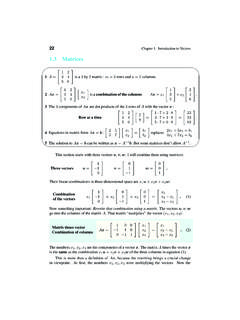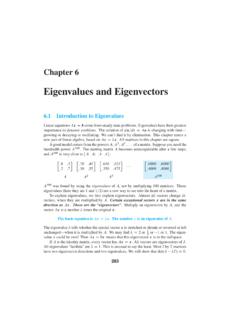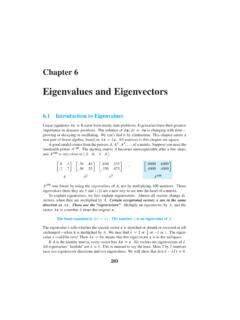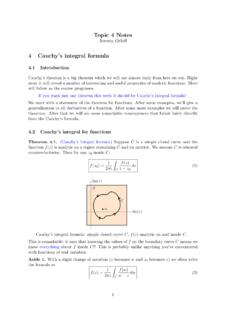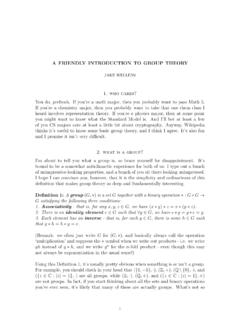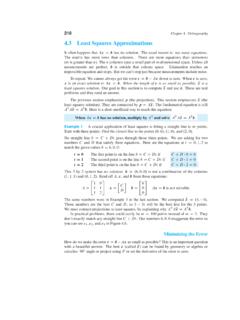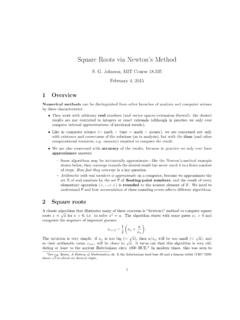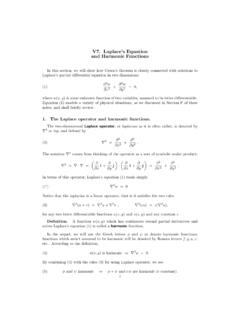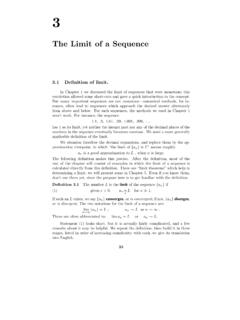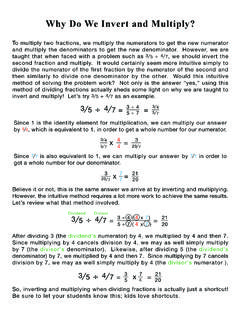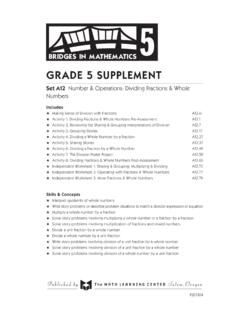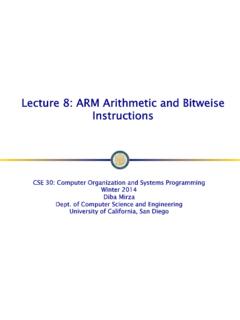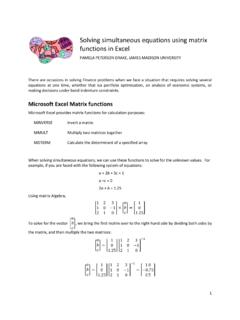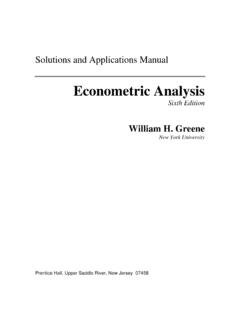Transcription of 2.5 Inverse Matrices
1 Inverse Inverse Matrices '&$%1If the square matrixAhas an Inverse , then bothA 1A=IandAA 1= test invertibility is elimination :Amust haven(nonzero) for invertibility is the determinant ofA:detAmust not be tests for invertibility isAx=0:x=0must be the only (same size) are invertible then so isAB:|(AB) 1=B 1A 1=Iisnequations forncolumns ofA 1. Gauss-Jordan eliminates[A I]to[I A 1].7 The last page of the book gives14equivalent conditions for a squareAto be a square matrix. We look for an Inverse matrix A 1of the same size,such thatA 1timesAequalsI. WhateverAdoes,A 1undoes. Their product is theidentity matrix which does nothing to a vector, soA 1Ax= 1might not a matrix mostly does is to multiply a vectorx.
2 MultiplyingAx=bbyA 1givesA 1Ax=A isx=A 1b. The productA 1 Ais like multiplying bya number and then dividing by that number. A number has an Inverse if it is not zero Matrices are more complicated and more interesting. The matrixA 1is called Ainverse. DEFINITIONThe matrixAisinvertibleif there exists a matrixA 1that inverts A:Two-sided inverseA 1A=IandAA 1=I.(1)Not all Matrices have inverses. This is the first question we ask about a square matrix:IsAinvertible ? We don t mean that we immediately calculateA 1. In most problemswe never compute it ! Here are six notes aboutA 1 The Inverse exists if and only if elimination producesnpivots(row exchangesare allowed). Elimination solvesAx=bwithout explicitly using the matrixA 2 The matrixAcannot have two different inverses.
3 SupposeBA=Iand alsoAC=I. ThenB=C, according to this proof by parentheses :B(AC) = (BA)CgivesBI=ICorB=C.(2)This shows that aleft-inverseB(multiplying from the left) and aright-inverseC(mul-tiplyingAfrom the right to giveAC=I) must be thesame 3 IfAis invertible, the one and only solution toAx=bisx=A 1b:MultiplyAx=bbyA 1Ax=A 2. Solving Linear EquationsNote 4(Important)Suppose there is a nonzero vectorxsuch thatAx= have an matrix can bring0back invertible, thenAx=0can only have the zero solutionx=A 10= 5A2by2matrix is invertible if and only ifad bcis not zero:2by2 Inverse : a bc d 1=1ad bc d b ca .(3)This numberad bcis thedeterminantofA. A matrix is invertible if its determinant is notzero (Chapter5).
4 The test fornpivots is usually decided before the determinant 6A diagonal matrix has an Inverse provided no diagonal entries are zero :IfA= thenA 1= 1 .Example 1 The2by2matrixA= 1 21 2 is not invertible. It fails the test in Note5,becausead bcequals2 2 = 0. It fails the test in Note3, becauseAx=0whenx= (2, 1). It fails to have two pivots as required by turns the second row of this matrixAinto a zero Inverse of a ProductABFor two nonzero numbersaandb, the suma+bmight or might not be invertible. Thenumbersa= 3andb= 3have inverses13and 13. Their suma+b= 0has no the productab= 9does have an Inverse , which is13times two matricesAandB, the situation is similar. It is hard to say much about theinvertibility ofA+B.
5 But theproductABhas an Inverse , if and only if the two factorsAandBare separately invertible (and the same size). The important point is thatA 1andB 1come inreverse order:IfAandBare invertible then so isAB. The Inverse of a productABis(AB) 1=B 1A 1.(4)To see why the order is reversed, multiplyABtimesB 1A 1. Inside that isBB 1=I: Inverse ofAB(AB)(B 1A 1) =AIA 1=AA 1= moved parentheses to multiplyBB 1first. SimilarlyB 1A Inverse Matrices85B 1A 1illustrates a basic rule of mathematics: Inverses come in reverse is also common sense: If you put on socks and then shoes, thefirst to be taken offare the. The same reverse order applies to three or more Matrices :Reverse order(ABC) 1=C 1B 1A 1.
6 (5)Example 2 Inverse of an elimination matrix. IfEsubtracts5times row1from row2,thenE 1adds5times row1to row2:EsubtractsE 1addsE= 1 0 0 51 00 0 1 andE 1= 1 0 051 00 0 1 .MultiplyEE 1to get the identity matrixI. Also multiplyE 1 Eto getI. We are addingand subtracting the same5times row1. IfAC=Ithen automaticallyCA= square Matrices , an Inverse on one side is automaticallyan Inverse on the other 3 SupposeFsubtracts4times row2from row3, andF 1adds it back:F= 1 0 00 1 00 4 1 andF 1= 1 0 00 1 00 4 1 .Now multiplyFby the matrixEin Example 2 to findF E. Also multiplyE 1timesF 1to find(F E) 1. Notice the ordersF EandE 1F 1!F E= 1 0 0 5 1 020 4 1 is inverted byE 1F 1= 1 0 051 00 41.
7 (6)The result is beautiful and correct. The productF Econtains 20 but its Inverse doesn row1from row2. ThenFsubtracts4times thenewrow2(changedby row1) from this orderF E, row3feels an effect from the orderE 1F 1, that effect does not happen. FirstF 1adds4times row2torow3. After that,E 1adds5times row1to row2. There is no20, because row3doesn tchange this orderE 1F 1, row3feels no effect from is why the next section choosesA=LU, to go back from the multipliers fall into place perfectly in the lower elimination orderFfollowsE. In reverse orderE 1followsF 1F 1is quick. The multipliers5,4fall into place below the diagonal of1 2. Solving Linear EquationsCalculatingA 1by Gauss-Jordan EliminationI hinted thatA 1might not be explicitly needed.
8 The equationAx=bis solved byx=A 1b. But it is not necessary or efficient to computeA 1and multiply it goes directly tox. And elimination is also the way to calculateA 1, as wenow show. The Gauss-Jordan idea is to solveAA 1=I,finding each column ofA the first column ofA 1(call thatx1)to give the first column ofI(callthate1). This is our equationAx1=e1= (1,0,0). There will be two more of the columnsx1,x2,x3ofA 1is multiplied byAto produce a column ofI:3columns ofA 1AA 1=A x1x2x3 = e1e2e3 =I.(7)To invert a3by3matrixA, we have to solve three systems of equations:Ax1=e1andAx2=e2= (0,1,0)andAx3=e3= (0,0,1). Gauss-Jordan findsA 1this Gauss-Jordan method computesA 1by solving allnequations the augmented matrix [Ab]has one extra columnb.
9 Now we have threeright sidese1,e2,e3(whenAis3by3). They are the columns ofI, so the augmentedmatrix is really the block matrix[A I]. I take this chance to invert my favorite matrixK,with2 s on the main diagonal and 1 s next to the2 s: Ke1e2e3 = 2 101 0 0 12 10 1 00 120 0 1 Start Gauss-Jordan onK 2 1 0 1 0 0032 1121 00 1 2 0 0 1 (12row1+row2) 2 1 0 1 0 0032 1121 00 04313231 (23row2+row3)We are halfway toK 1. The matrix in the first three columns isU(upper triangular). Thepivots2,32,43are on its diagonal. Gauss would finish by back contributionof Jordan isto continue with elimination! He goes all the way to thereduced echelon formR=I.
10 Rows are added to rows above them, to producezeros above the pivots: Zero abovethird pivot 2 1 0 1 0 003203432340 04313231 (34row3+row2) Zero abovesecond pivot 2 0 03211203203432340 04313231 (23row2+row1)The final Gauss-Jordan step is to divide each row by its new pivots are Inverse Matrices87We have reachedIin the first half of the matrix, becauseKis threecolumns ofK 1are in the second half of[I K 1]:(divide by2)(divide by32)(divide by43) 10 0341214010121120 01141234 = Ix1x2x3 = IK 1 .Starting from the3by6matrix[K I], we ended with[I K 1]. Here is the wholeGauss-Jordan process on one line for any invertible matrixA:Gauss-JordanMultiply A I byA 1to get[I A 1].
